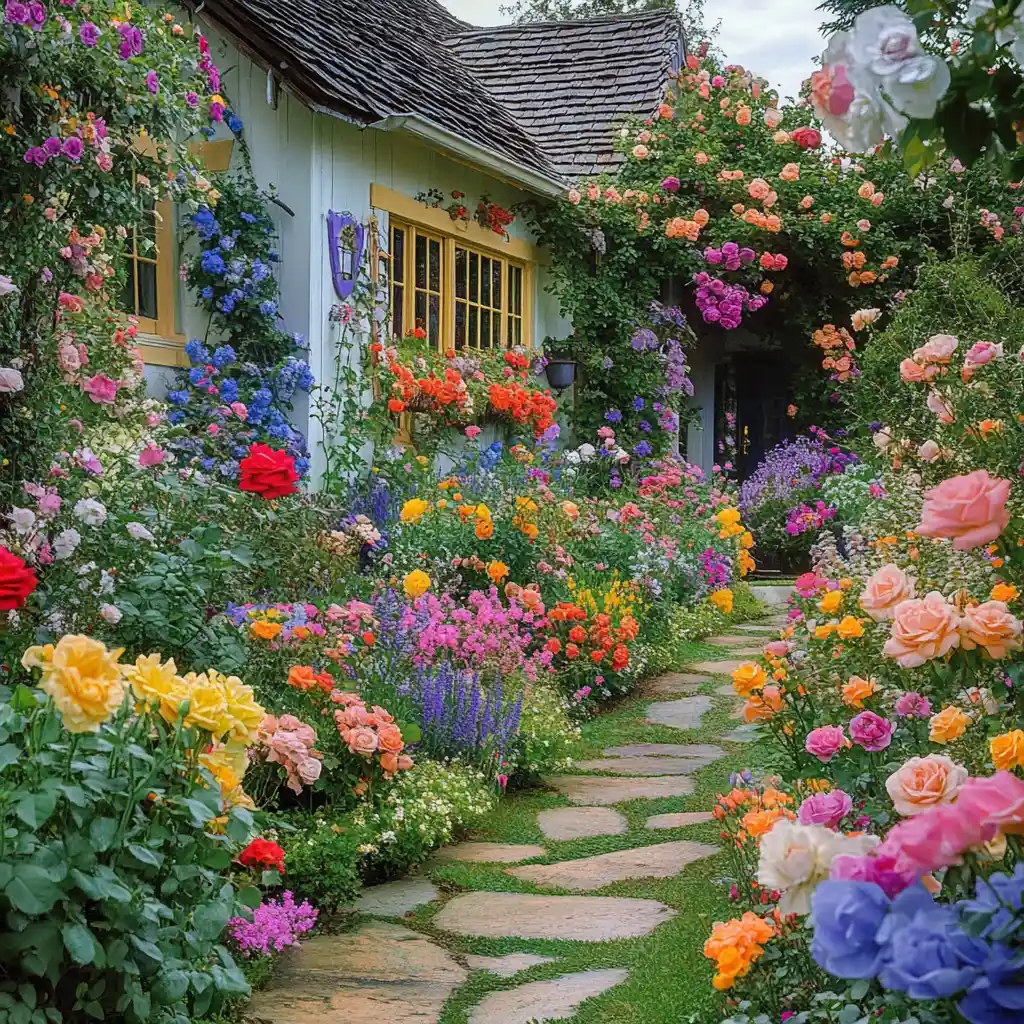Small garden design is a rewarding way to turn even the tiniest balcony or backyard into a colorful, fragrant retreat. With smart choices in layered planting and layout, you can create a blooming sanctuary that supports pollinators and reflects your style. Whether you’re working with containers or ground beds, these flower garden ideas will help you design a vibrant space that thrives in any season.
Table of Contents
Why Create a Flower Garden?
In the fast pace of modern life, having a flower garden—even a small one—offers a calming retreat and a much-needed connection to nature. Small garden design doesn’t just beautify your space; it nurtures your well-being and enriches the environment around you.
Reasons to Design Your Own Flower Garden:
- A Creative Outlet: Arranging colors, shapes, and textures in a limited space challenges and inspires creativity.
- A Peaceful Escape: Even a small garden can become a serene sanctuary for morning coffee, meditation, or quiet reflection.
- Support for Pollinators: Strategic planting of native and nectar-rich flowers helps support bees, butterflies, and other vital pollinators.
- Increased Curb Appeal: Thoughtful flower placement near entryways or patios can dramatically improve your home’s first impression.
Flower gardening isn’t just a hobby—it’s a personal statement and a gentle form of therapy, all wrapped into one lush, fragrant corner of your world.
Benefits of a Well-Designed Flower Garden
Thoughtful small garden design yields more than just aesthetic appeal—it creates a space that enhances both your lifestyle and the ecosystem around you. Even limited square footage, when well-planned, can provide a surprising range of benefits.
Mental and Emotional Wellness
Studies consistently show that spending time in nature reduces stress, anxiety, and depression. A flower garden provides:
- Daily moments of mindfulness
- A screen-free outlet for relaxation
- Opportunities for hands-on engagement with living things
Seasonal Beauty in Compact Spaces
Smart design ensures your small garden is never dormant. With layered planting and careful bloom selection, your flower patch can offer:
- Spring bulbs for early pops of color
- Summer perennials for volume and variety
- Autumn tones from ornamental grasses or fall foliage
- Winter interest through structure, evergreens, or dried seed heads
Property Value & Environmental Perks
A vibrant garden, no matter its size, adds curb appeal and:
- Increases home value
- Improves air quality
- Creates habitat for birds, bees, and butterflies
In short, a well-planned flower garden transforms your small space into a thriving micro-environment full of life, color, and serenity.
Common Mistakes to Avoid
Even experienced gardeners can fall into some common traps—especially when working within limited space. In small garden design, every inch matters, so avoiding these mistakes can save you time, money, and frustration.
1. Choosing the Wrong Plants
Not all flowers thrive in all climates. Failing to consider your USDA hardiness zone or your soil’s pH can lead to poor growth or plant failure. Always:
- Check plant tags or guides for your specific region.
- Prioritize plants suited to your microclimate (sun, wind, shade).
2. Overcrowding
In small spaces, it’s tempting to pack in as many flowers as possible. But overcrowding:
- Stifles airflow and promotes disease.
- Prevents plants from reaching their full size and shape.
- Makes maintenance more difficult.
Leave breathing room—your plants and design will benefit from it.
3. Ignoring Year-Round Appeal
Many gardens are stunning in spring and summer but fade into dullness come fall and winter. In small gardens, year-round beauty is essential:
- Use evergreens and ornamental grasses for winter structure.
- Include flowers with staggered bloom times.
4. Skipping a Plan
Winging it rarely works well in limited space. Without a plan, it’s easy to:
- Create awkward layouts.
- Miss opportunities for layering.
- End up with a garden that’s hard to maintain or enjoy.
Sketch a basic layout before planting—it doesn’t have to be fancy, just functional.
Planning Your Flower Garden
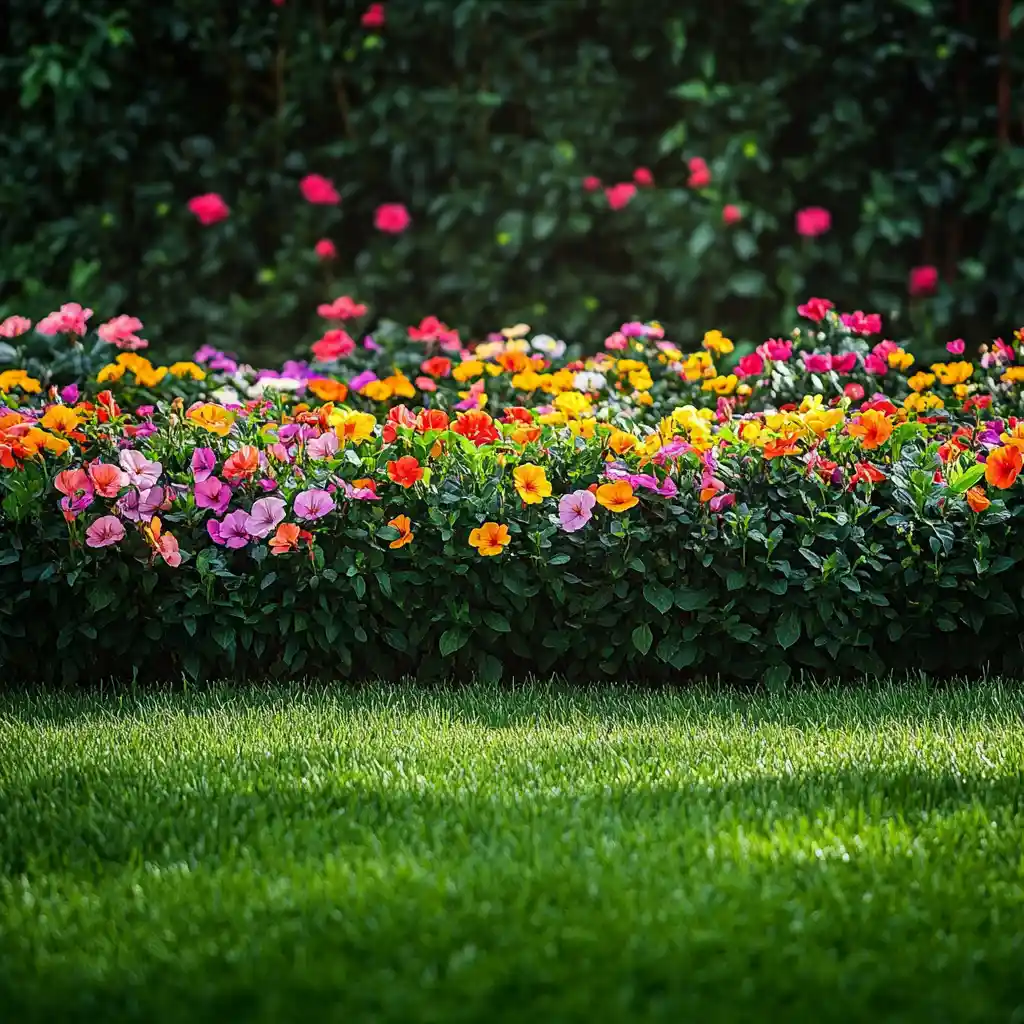
Proper planning is the foundation of a successful small garden design. In compact spaces, every detail—from sunlight exposure to pathway width—impacts the overall harmony and health of your garden. A little preparation up front ensures lasting beauty and ease of care.
Step 1: Assess Your Space
Before planting a single flower, take a close look at your site:
- Sunlight: Track how the sun moves across your garden. Is it full sun (6+ hours), partial, or full shade?
- Soil: Test for pH and drainage. Sandy, clay-heavy, or loamy soils all require different amendments.
- Water access: Is there a hose nearby? Will you need a watering can, drip irrigation, or soaker hose?
Step 2: Define Your Style and Color Theme
A clear aesthetic keeps your small garden from looking chaotic. Ask yourself:
- Do you prefer a cottage garden, minimalist modern, or pollinator-friendly wild look?
- Are you drawn to cool hues (lavender, blue, white) or bold warm tones (red, orange, yellow)?
- Want a monochromatic theme for elegance or contrasting colors for excitement?
Step 3: Sketch a Layout
Draw your space on paper (to scale, if possible). Mark areas for:
- Tall plants (back or center)
- Mid-size blooms (middle layer)
- Low-growing or groundcover plants (front/edges)
- Paths or stepping stones
- Focal points (pot, bench, sculpture)
Planning doesn’t need to be complicated—it just needs to serve your vision and prevent costly mistakes later.
Choosing the Right Location
In small garden design, where every inch is precious, selecting the ideal spot for your flower bed is one of the most impactful decisions you’ll make. A well-placed garden not only ensures plant health but also enhances usability and aesthetics.
Match Plants to Light Conditions
Every plant has its preference—some crave the sun, while others wilt without shade. Take at least 2–3 days to observe how sunlight moves through your garden at different times. Then:
- Full-sun plants (e.g., coneflowers, lavender) need 6–8 hours of direct sunlight daily.
- Partial shade plants (e.g., astilbes, impatiens) thrive in filtered light or morning sun with afternoon shade.
- Full-shade lovers (e.g., ferns, hostas) prefer minimal direct sunlight.
Choose flowers that naturally align with the light conditions of your chosen spot.
Observe Wind and Microclimates
Small gardens are often affected by nearby buildings, walls, or fences. These structures can:
- Block or reflect sunlight
- Funnel wind through narrow spaces
- Create “hot spots” on sunny patios or balconies
Use these conditions to your advantage by grouping plants accordingly or shielding delicate flowers with windbreaks like trellises or shrubs.
Accessibility and Enjoyment
Don’t just think like a gardener—think like someone who will enjoy the space.
- Can you see the garden from a window or patio?
- Is there room to walk through or sit beside it?
- Will water, fertilizer, and tools be easy to bring in?
A great location is one you’ll actually use and appreciate, not just admire from afar.
Soil Quality and Drainage
In any garden, soil is the foundation—but in small garden design, where space for plant recovery is limited, getting it right from the start is crucial. Healthy soil supports strong roots, lush blooms, and efficient water use, even in compact environments.
Test Your Soil
Before planting, it’s wise to assess:
- pH level – Most flowers prefer a slightly acidic to neutral pH (6.0–7.0).
- Texture – Rub a sample between your fingers. Is it gritty (sandy), sticky (clay), or soft and crumbly (loam)?
- Drainage – Dig a small hole, fill it with water, and see how quickly it drains. Slow drainage may require intervention.
Improve with Compost
No matter your soil type, adding organic matter is key:
- Compost improves fertility and texture.
- Aged manure adds slow-release nutrients.
- Coconut coir or leaf mold helps with moisture retention in sandy soils.
In a small space, it’s worth investing in quality amendments since the entire garden relies on a limited volume of soil.
Raised Beds and Containers
If your native soil is poor or space is extremely limited, raised beds or large containers can be a game-changer:
- Improve drainage immediately
- Allow you to fully control soil quality
- Define the garden space neatly
Raised beds especially benefit small garden design by creating layers and structure in compact plots.
Install Smart Watering Systems
Efficient water use is essential in tight quarters:
- Soaker hoses deliver water directly to roots.
- Drip irrigation is great for raised beds and containers.
- Avoid overhead watering to reduce fungal issues.
Water deeply but infrequently to encourage deep root growth and healthy blooming.
Space and Layout Planning
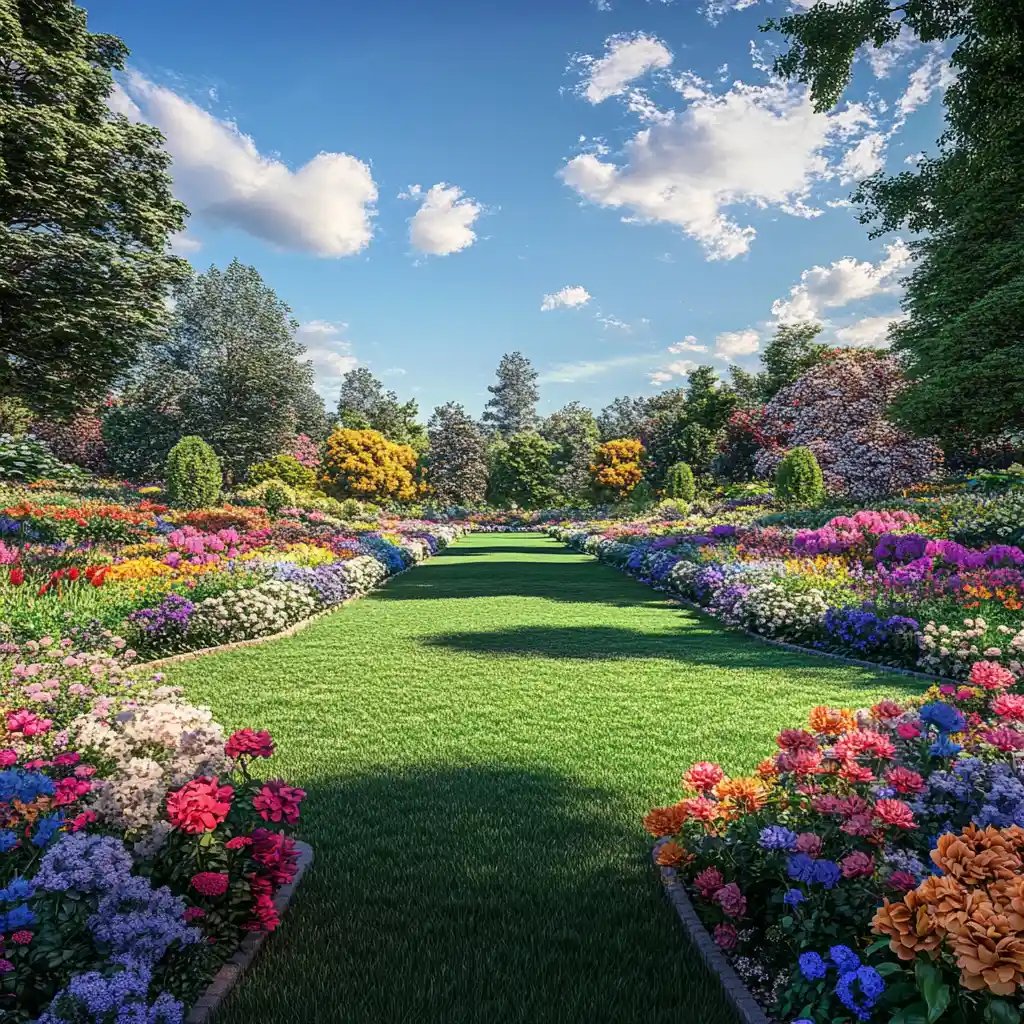
When working with limited square footage, smart small garden design is all about layout. A well-planned space maximizes beauty, minimizes maintenance, and allows every plant to shine without feeling cluttered.
Design with Plant Maturity in Mind
One of the most common mistakes in small gardens is underestimating how big plants will get. Avoid future overcrowding by:
- Researching mature height and spread of each flower before planting
- Leaving room between plants to grow naturally
- Using spacing to create a sense of openness and rhythm
Spacing properly also improves airflow, which helps reduce disease and makes gardening more enjoyable.
Use Layering for Visual Balance
Layering isn’t just for large landscapes—it’s crucial in small gardens to avoid a flat, one-dimensional look.
- Back row: Tall plants like delphiniums, sunflowers, or ornamental grasses
- Middle layer: Mid-height flowers such as coreopsis, daisies, or bee balm
- Front row: Low growers like alyssum, creeping thyme, or pansies
Layering adds depth and ensures every flower gets its moment in the sun—literally and visually.
Create Accessible Pathways
Even in a small garden, you’ll need to access plants for pruning, watering, and enjoying the blooms. Include:
- Stepping stones, gravel strips, or even wooden planks
- Paths that allow movement without stepping on soil (which can compact roots)
- Curves or diagonal lines to visually expand space
A narrow but intentional path can make your garden feel larger and more functional.
Angle for the Best Views
If your garden is viewed primarily from one angle—like through a kitchen window or patio—design it like a stage:
- Put focal points (a large pot, colorful bed, or sculpture) in the line of sight
- Arrange plants so nothing essential is hidden behind taller blooms
- Consider how your garden looks from eye level, not just from above
Small doesn’t mean simple—it means intentional. A well-laid-out small garden feels immersive, not limited.
Selecting Flowers for Your Garden
When it comes to small garden design, flower selection plays a critical role. You’ll want blooms that offer impact, work well together, and thrive in your specific conditions—all while making the most of limited space.
Consider Key Selection Factors:
To create a vibrant, functional flower garden, choose varieties based on:
- Color: Use a cohesive palette to avoid visual clutter.
- Bloom Time: Stagger flowering periods so your garden has continuous interest.
- Texture and Form: Mix foliage shapes and flower types for visual depth.
- Scent: Add a few fragrant plants to enhance sensory appeal.
- Pollinator Appeal: Incorporate nectar-rich blooms to support bees and butterflies.
Mix Perennials and Annuals
A smart small garden design balances structure and seasonal flexibility:
- Perennials (e.g., echinacea, salvia, daylilies): Return yearly, require less maintenance, and provide the “bones” of your garden.
- Annuals (e.g., petunias, marigolds, zinnias): Deliver long-lasting bursts of color and can be changed each season.
Using both types allows you to experiment with color themes while building a long-term layout.
Compact and Multi-Bloom Varieties
In tight spaces, choose flowers that offer a big return:
- Compact forms: Many popular flowers come in “dwarf” or space-saving varieties perfect for pots or tight beds.
- Repeat bloomers: Varieties like geraniums and calibrachoas offer color all season long.
- Vertical growers: Climbing roses, clematis, or morning glories on a trellis add height without eating up floor space.
With thoughtful plant selection, even a modest plot can look abundant, diverse, and vibrant.
Perennials vs. Annuals
Understanding the difference between perennials and annuals is vital in small garden design, especially when you’re trying to balance low maintenance with high impact. A mix of both can deliver continuous blooms and structure in a limited footprint.
Perennials: The Garden’s Foundation
Perennials are plants that return each year, growing stronger over time. They:
- Provide long-term structure and form
- Require less replanting and lower annual costs
- Often bloom for shorter periods but with dependable regularity
Examples: Coneflowers, black-eyed Susans, yarrow, coreopsis
Tip: In small gardens, group perennials by height and bloom time to ensure they don’t crowd each other or create dead zones when not in bloom.
Annuals: Seasonal Stars
Annuals complete their life cycle in one season, but what they lack in longevity, they make up for in energy:
- Deliver intense, prolonged blooms
- Allow for experimentation with color schemes
- Can fill gaps while perennials mature
Examples: Zinnias, cosmos, petunias, nasturtiums
Tip: Use annuals in containers or front borders so they’re easy to refresh seasonally.
Combining Both for Best Results
In a small garden, it’s all about smart layering and flexibility:
- Use perennials for stability and backbone.
- Accent with annuals for color variation and seasonal refresh.
- Choose self-seeding annuals (like calendula or poppies) for low-maintenance color that returns naturally.
This strategic blend ensures your garden looks vibrant throughout the seasons without overwhelming your available space.
Color and Bloom Time Coordination
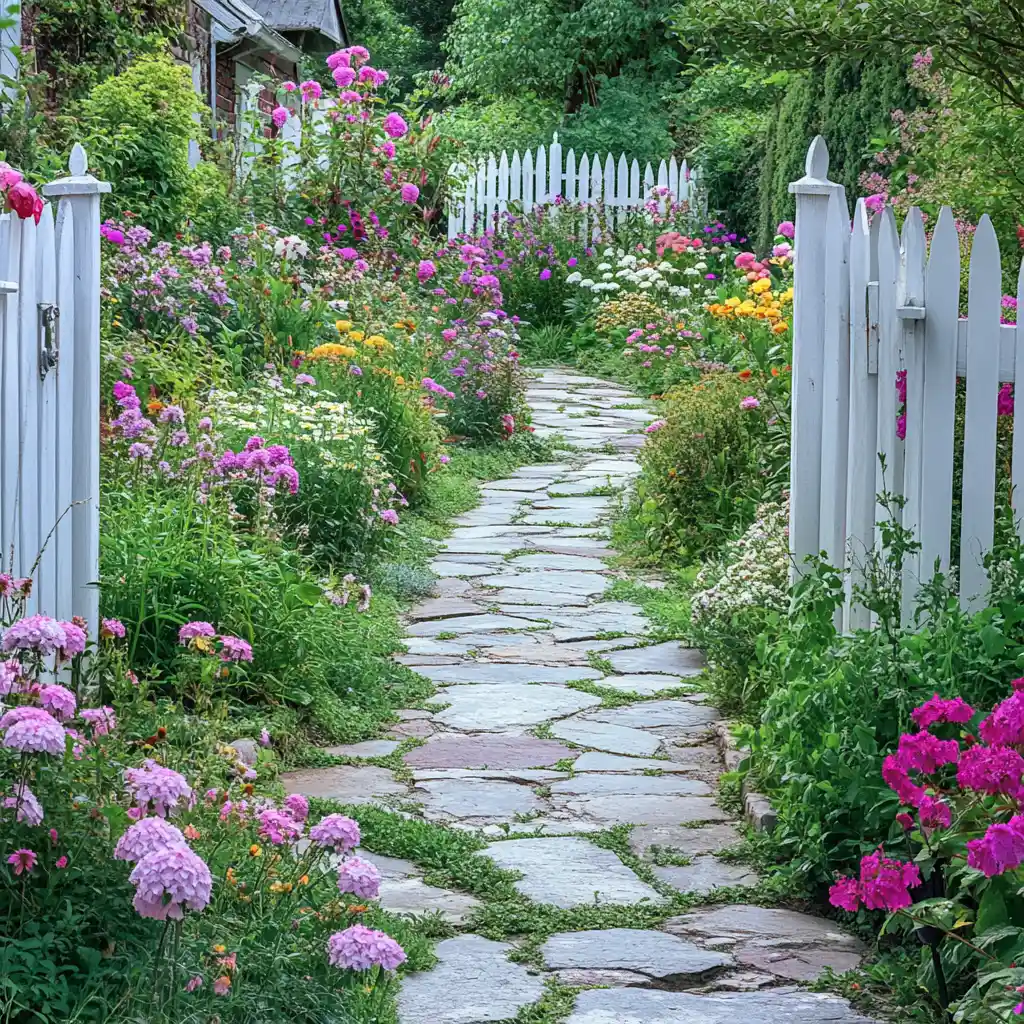
In small garden design, color and timing are everything. Because you’re working with limited space, every plant has to pull its weight—not just in terms of beauty, but in when and how it contributes to the overall display.
Crafting a Color Palette
Start by choosing a color scheme that suits your style and surroundings. This will help avoid a chaotic or mismatched look.
- Complementary colors (e.g., purple and yellow) create vibrant contrast.
- Analogous colors (e.g., blue, purple, pink) offer a harmonious, calming vibe.
- Monochromatic schemes (shades of one color) can make small gardens appear more spacious.
Stick to 2–4 main colors to maintain cohesion without sacrificing variety.
Plan for Continuous Bloom
Avoid the common issue of a garden that peaks too early. Use flowers with staggered bloom times to keep your garden colorful throughout the seasons.
- Early bloomers: Daffodils, pansies, tulips
- Mid-season stars: Peonies, lilies, salvia
- Late bloomers: Sedum, asters, chrysanthemums
Pro Tip: Use a bloom calendar or plant tags to plan succession. In tight spaces, this prevents periods where the garden looks bare or tired.
Layering for Seasonal Transitions
Incorporate flowers that fade gracefully or produce interesting seed heads after blooming. This ensures:
- A smoother transition between seasons
- Extended visual interest beyond peak bloom
- Less need for mid-season replanting
Smart bloom coordination transforms a small garden into a space that’s always in motion—visually dynamic, colorful, and full of life from spring through frost.
Incorporating Fragrance
While color may draw the eye, fragrance captures the soul—and in small garden design, scent has the power to transform a tiny space into an immersive, luxurious experience. Whether it’s a breezy patio or a compact flower bed, thoughtful use of aromatic plants elevates the atmosphere.
Why Fragrance Matters
- Enhances relaxation: Scents like lavender and chamomile are known to reduce stress.
- Attracts pollinators: Bees and butterflies are drawn to many fragrant flowers.
- Creates memorable moments: A scented breeze can trigger nostalgia and emotional connection.
In a small space, scent becomes more concentrated and intimate—making your garden not just look beautiful, but feel beautiful.
Top Fragrant Flower Picks for Small Spaces
Choose varieties that combine fragrance with compact growth habits:
- Lavender – Compact cultivars like ‘Munstead’ thrive in pots and sunny borders.
- Sweet Alyssum – Low-growing and ideal for edging or containers, with a soft honey-like scent.
- Jasmine – Star jasmine or dwarf varieties work well in hanging baskets or trellises.
- Roses – Opt for small, repeat-blooming varieties like ‘Sweet Drift’ or ‘The Fairy’.
- Dianthus (Pinks) – Spicy-scented blooms that thrive in full sun and well-drained soil.
Placement is Key
For maximum enjoyment:
- Near seating areas – Enjoy the scent while relaxing or dining.
- Along paths or entrances – Let guests experience fragrance up close.
- Under windows – So the aroma drifts indoors.
Tip: Avoid planting too many highly scented varieties together. Overmixing can overwhelm rather than delight.
In a well-designed small garden, fragrance is the final layer that completes the sensory experience—gentle, inviting, and unforgettable.
Native & Pollinator-Friendly Flowers
One of the smartest strategies in small garden design is choosing plants that are both beautiful and beneficial. Native and pollinator-friendly flowers support local ecosystems while requiring less maintenance—making them ideal for gardeners with limited space and time.
Why Go Native?
Native plants are naturally adapted to your region’s soil, rainfall, and climate. That means they:
- Thrive with minimal intervention
- Resist local pests and diseases
- Require less watering and fertilizing
In small gardens, where efficiency matters, natives deliver beauty without extra effort.
Boosting Biodiversity
Pollinators like bees, butterflies, and hummingbirds rely on certain flowers for nectar and habitat. A garden that supports them also promotes food production and a healthy environment.
Top Pollinator-Friendly Choices (varies by region):
- Echinacea (Coneflower) – Long-blooming and drought-tolerant
- Bee Balm (Monarda) – Irresistible to hummingbirds and butterflies
- Milkweed (Asclepias) – Essential for monarch butterflies
- Black-eyed Susan (Rudbeckia) – Hardy and cheerful
- Goldenrod (Solidago) – Late-season food source
Design Tips for Small Pollinator Gardens
- Cluster plants: Group 3–5 of the same species together. It’s easier for pollinators to locate.
- Succession planting: Choose a variety of bloom times to support pollinators from spring to fall.
- Avoid pesticides: Even organic ones can harm beneficial insects.
Incorporating native and pollinator-friendly flowers isn’t just eco-conscious—it’s a low-maintenance, high-reward choice that brings movement, color, and purpose to your compact flower garden.
Designing the Garden Layout
Great small garden design isn’t just about what you plant, but how you arrange it. Layout determines how your space feels, flows, and functions—especially when square footage is limited. A smart design transforms a tight area into a blooming sanctuary that looks intentional and inviting.
Create a Focal Point
Even a tiny garden benefits from having a visual anchor. Focal points help draw the eye and add structure to the layout.
Ideas for focal points:
- A bold flower bed with striking colors
- A small sculpture or birdbath
- A flowering shrub or topiary in a container
- A climbing rose or clematis on a trellis
Place focal elements where they’ll be seen from key viewpoints—like a patio, pathway, or window.
Layering for Height and Dimension
Use vertical space to your advantage, especially in narrow or enclosed gardens.
- Tall plants (e.g., hollyhocks, ornamental grasses) at the back or center
- Mid-height flowers (e.g., echinacea, salvias) in the middle
- Low growers (e.g., creeping thyme, alyssum) in front or at edges
Layering not only maximizes visual interest but also ensures every plant gets adequate sunlight and airflow.
Incorporate Structures and Seating
Hardscaping adds both functionality and charm. Even in a small plot, consider adding:
- Arbors or trellises to support climbers and add vertical drama
- A small bench or stool for seating and relaxation
- Raised beds or containers to define space and improve accessibility
These features offer architectural contrast to soft foliage and flowers—adding elegance and making your garden feel like an outdoor room.
Flow and Movement
Think about how someone will experience the space.
- Add stepping stones, curves, or winding paths to suggest movement.
- Avoid rigid lines; instead, allow plants to spill gently over edges for a natural feel.
- Keep maintenance paths wide enough (even 12–18″) to comfortably access plants.
In a compact space, layout is your most powerful design tool. Use it to create depth, highlight beauty, and make every inch feel intentional and enchanting.
Planning for Year-Round Interest
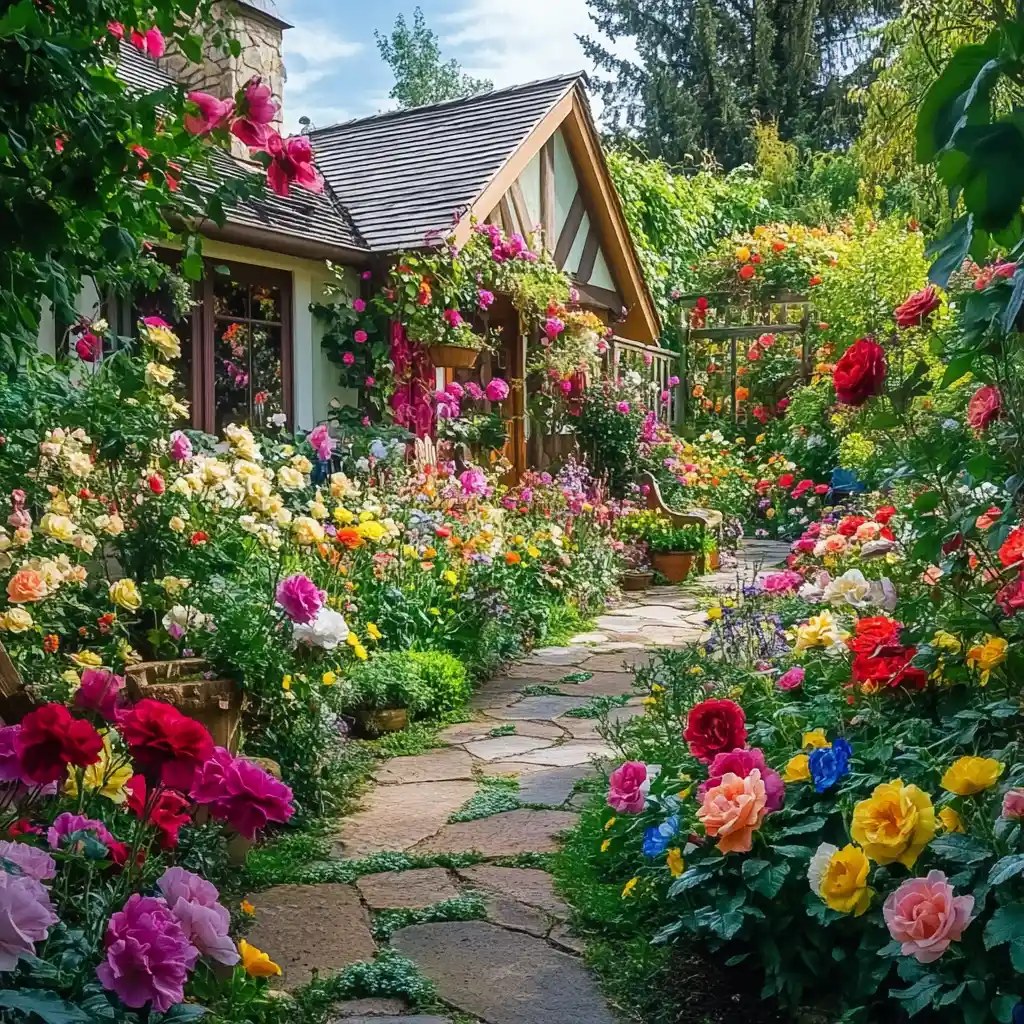
One of the hallmarks of expert small garden design is making sure your space doesn’t peak for just a few weeks—and then fade. By planning for year-round interest, you ensure your garden is visually engaging and enjoyable in every season, even in a compact footprint.
Think Beyond Spring and Summer
Many small gardens are stunning in spring but go dormant too early. Prevent that by selecting plants and features that shine across all four seasons.
🌸 Spring:
- Bulbs like tulips, daffodils, and crocus for early color
- Flowering shrubs (e.g., forsythia, lilac) for structure and bloom
🌼 Summer:
- Long-blooming perennials like salvia, daylilies, and coneflowers
- Annuals like petunias or cosmos for vibrant, extended displays
🍂 Fall:
- Foliage-rich plants like heuchera or ornamental grasses
- Late bloomers like sedum, asters, or chrysanthemums
❄️ Winter:
- Evergreen groundcovers or dwarf conifers
- Architectural elements like trellises, birdbaths, or seed heads from summer flowers
- Frost-tolerant plants (e.g., hellebores) for late-season color
Add Texture and Structure
Not everything needs to bloom to be beautiful. Foliage and form carry the visual weight during quieter months.
- Use a variety of leaf shapes, colors, and textures
- Include structural elements: raised beds, potted trees, or a decorative obelisk
- Leave ornamental seed heads (like those on echinacea or allium) for winter interest and bird food
Use Containers Strategically
In small gardens, containers allow for easy seasonal swaps:
- Add pansies in spring, zinnias in summer, mums in fall, and mini evergreens in winter
- Move pots around for sunlight or visual balance
With intentional planting and a touch of planning, your garden can stay dynamic, beautiful, and full of character every month of the year.
Planting & Care Essentials
Even the best small garden design won’t thrive without proper planting and ongoing care. In a compact space, healthy plants are especially important, since there’s little room for underperformers. A bit of attention goes a long way toward lush blooms and lasting beauty.
How to Plant for Success
Follow these best practices for strong, healthy starts:
- Dig wide, not deep: Make your planting hole twice as wide as the root ball but just as deep.
- Loosen the roots: Gently tease apart any circling roots to help the plant establish.
- Backfill with care: Use quality soil mixed with compost. Firm the soil gently to eliminate air pockets.
- Water deeply: Give a thorough drink after planting to help roots settle and bond with the soil.
Smart Watering Strategies
Over- or under-watering is one of the most common small garden mistakes. Stick to this routine:
- Water early in the morning or late in the evening to minimize evaporation.
- Water deeply but less frequently to promote strong root growth.
- Use soaker hoses or drip irrigation for consistent moisture without wasting water.
Mulching Matters
Mulch is a multitasking powerhouse in any garden—but especially in small ones where every plant counts.
- Retains moisture and reduces watering needs
- Suppresses weeds, saving time and space
- Regulates soil temperature, protecting roots in extreme heat or cold
Apply a 2–3 inch layer of organic mulch like bark chips or straw. Keep it a few inches away from stems to prevent rot.
Fertilizing for Long-Term Growth
Flowers need nutrients to bloom their best. In small gardens, use:
- Compost for slow-release organic feeding
- Balanced granular fertilizer in spring and mid-season (e.g., 10-10-10)
- Liquid feed every few weeks for containers or heavy bloomers
Avoid over-fertilizing, which can lead to excess foliage at the expense of flowers.
Ongoing Maintenance
Regular care keeps your space thriving:
- Deadhead faded blooms to encourage repeat flowering
- Prune for shape and airflow
- Weed weekly to prevent competition
- Inspect for pests or disease and treat early
Consistent care turns a well-designed flower bed into a living masterpiece—and keeps your small garden looking fabulous all season long.
Decorative Additions
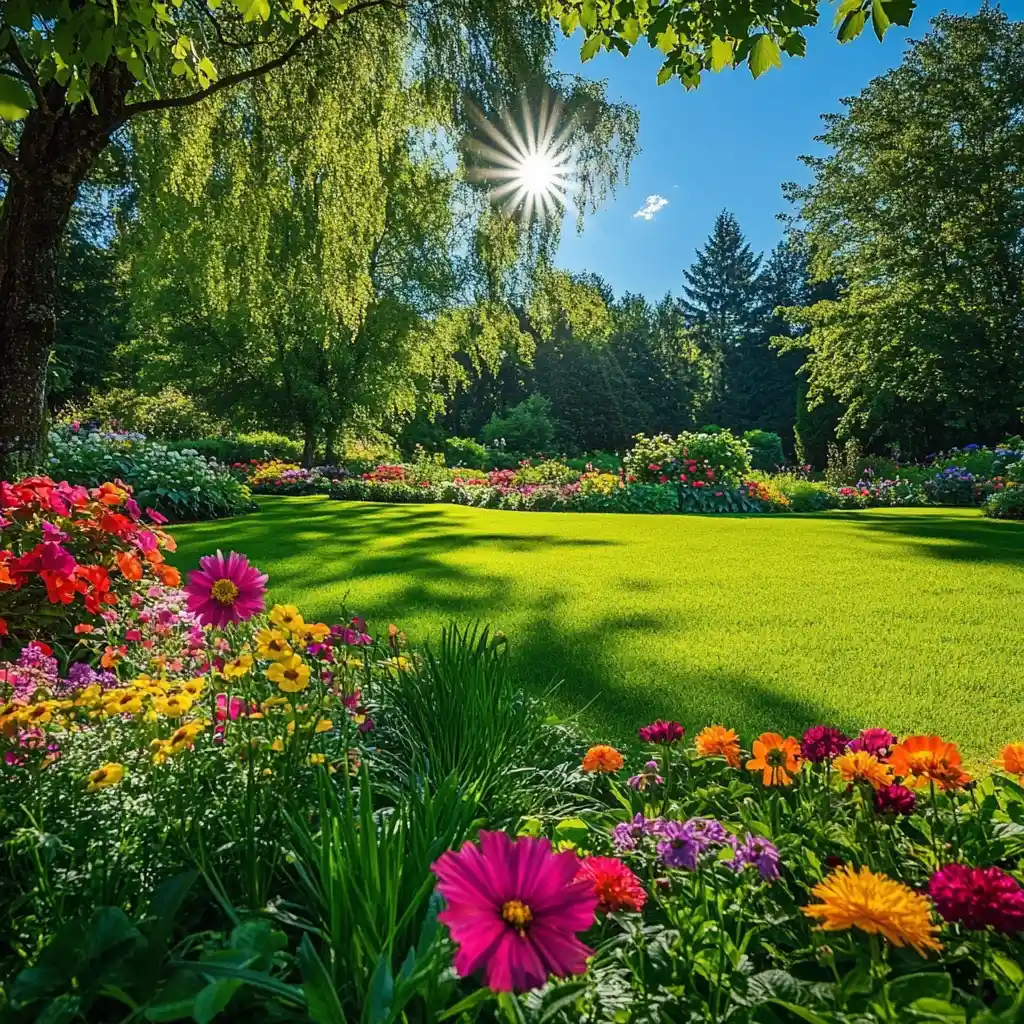
In small garden design, decorative elements do more than just beautify—they define space, add dimension, and express your unique style. Because you’re working within limited square footage, each element must be both intentional and impactful.
Garden Art: Small Accents, Big Impact
Well-placed decor pieces can act as focal points or subtle accents. Think of them as the jewelry of your garden.
Popular ideas:
- Sculptures or statues – Even a small stone figure can anchor a flower bed.
- Driftwood or upcycled pieces – Add natural or rustic charm.
- Birdbaths or feeders – Invite wildlife while enhancing aesthetics.
- Wind chimes – Offer soothing sound and vertical interest.
Tip: Stick to a consistent style (modern, whimsical, natural) to avoid visual clutter.
Define the Space with Pathways and Edging
In tight gardens, clean lines and defined spaces create order and enhance flow.
- Pathways: Use gravel, bricks, stepping stones, or wood slices to guide movement.
- Edging: Keeps soil and mulch in place while preventing grass or weeds from creeping in.
Compact-friendly materials:
- Metal or composite edging for crisp modern lines
- Natural stone for a rustic, organic look
- Bricks or recycled pavers for traditional charm
Water Features: Tranquility in a Small Footprint
You don’t need a pond to enjoy the serenity of water in your garden.
- Tabletop fountains provide sound and movement
- Mini pond containers can support aquatic plants and attract wildlife
- Birdbaths double as a decor piece and pollinator oasis
Just one small water feature can change the mood of your entire garden, making it feel more peaceful and inviting.
Incorporating these decorative elements gives your garden layers of personality—and helps turn a beautiful plant display into a truly immersive experience.
Lighting Your Flower Garden
Thoughtful lighting transforms your small garden design from a daytime retreat into a magical nighttime escape. With the right fixtures, you can highlight plants, create ambiance, and safely navigate your garden even after dark—all without taking up valuable space.
Why Garden Lighting Matters
- Extends usability: Enjoy your garden in the evening hours
- Adds security: Illuminated paths and corners deter intruders
- Enhances design: Highlights key plants or structures, adding drama and depth
Types of Garden Lighting for Small Spaces
Here are space-efficient lighting options that blend function and beauty:
- Path Lights – Guide movement through beds or along walkways
- Spotlights – Showcase focal points like a small tree, statue, or flower cluster
- String Lights – Add charm overhead or wrapped around trellises
- Solar Lights – Easy to install and eco-friendly; ideal for low-maintenance setups
Tip: Use warm-white bulbs (2700–3000K) to create a cozy, natural-looking glow.
Placement Tips
In compact gardens, light placement is crucial. Follow these tips:
- Place spotlights at ground level, angled upward to highlight foliage or features.
- Use low-glare fixtures to prevent harsh shadows or light pollution.
- Light only what matters—a small garden doesn’t need to be fully illuminated.
Layer for Ambiance
Mix different light sources to create depth and mood:
- Combine subtle uplighting for trees with soft string lights overhead.
- Place tea lights in glass jars or lanterns around seating areas.
- Use motion or timer-based lighting for ease and energy efficiency.
With just a few well-placed lights, your small garden can feel expansive, elegant, and welcoming—no matter the hour.
Seasonal Flower Garden Care
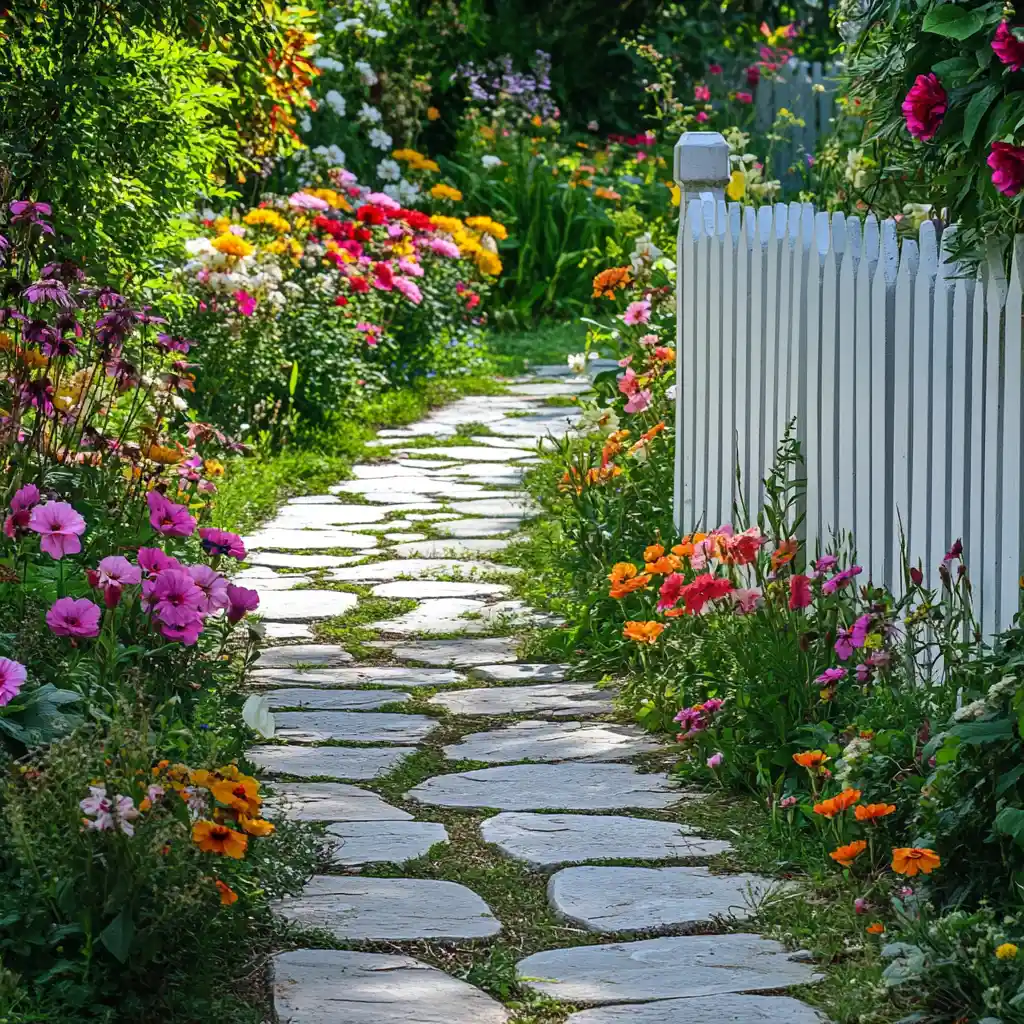
A truly thriving small garden design isn’t just planted and forgotten—it’s nurtured through the seasons. With a few timely tasks, you can keep your garden healthy, colorful, and low-maintenance all year long.
🌱 Spring: Prep and Plant
Spring is when your garden comes alive.
To-do list:
- Clean up dead leaves, stems, and winter debris
- Test and amend soil with compost or organic fertilizer
- Plant early-season flowers (pansies, daffodils, violas)
- Divide perennials that have outgrown their space
Tip: Start a garden journal to track what you planted, where, and how it performed.
☀️ Summer: Maintain and Monitor
Summer is peak bloom time—but also the season of heat and pests.
Focus on:
- Watering deeply 2–3 times per week, early or late in the day
- Deadheading to promote repeat blooming
- Fertilizing lightly if needed (especially annuals and containers)
- Weeding and mulching to conserve moisture and block competition
- Inspecting for pests like aphids, slugs, or spider mites
Tip: Shade delicate plants with lightweight cloth or place containers in dappled light to reduce stress.
🍁 Fall: Cleanup and Prep
Autumn sets the stage for next season’s success.
Fall tasks:
- Remove spent annuals and diseased foliage
- Cut back perennials after the first frost (unless you’re leaving seed heads for birds)
- Plant spring bulbs like tulips, alliums, and hyacinths
- Mulch beds to insulate soil and roots over winter
Tip: Use this time to revise your layout—what worked? What didn’t?
❄️ Winter: Protect and Plan
Even in cold climates, your garden still needs attention.
Winter checklist:
- Protect tender plants with burlap, frost cloth, or mulch
- Store pots indoors or insulate them to prevent cracking
- Order seeds or make your spring wishlist
- Sharpen tools and organize your shed or storage
Tip: Leave ornamental grasses and seed heads for winter interest and bird feeding.
Conclusion
Small garden design isn’t about limitations—it’s about creativity. With layered plants and smart layout, even a tiny space can bloom year-round. Whether you’re just starting out or refining your skills, these beginner-friendly ideas show how to design a flower garden that’s both personal and beautiful.


